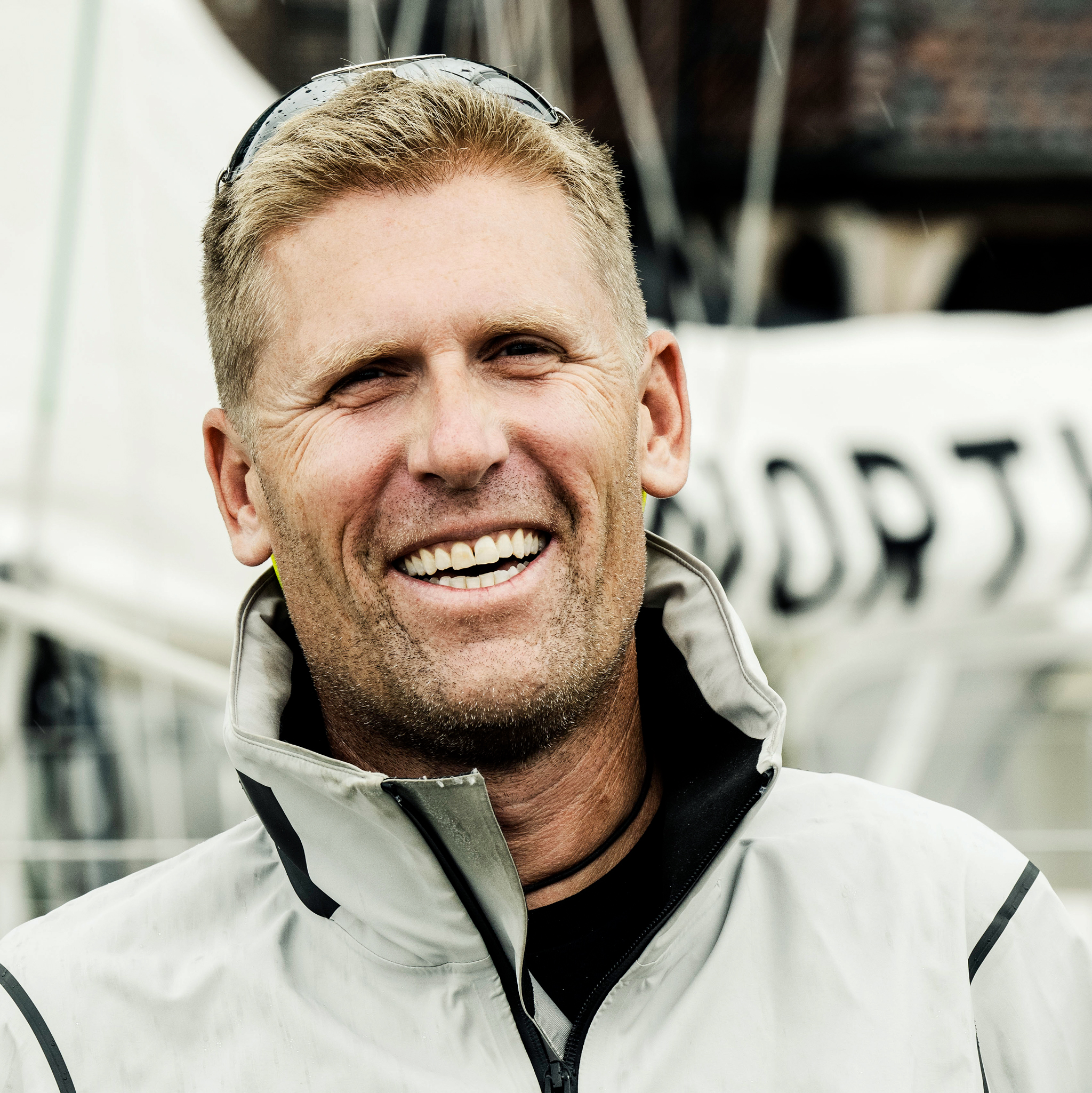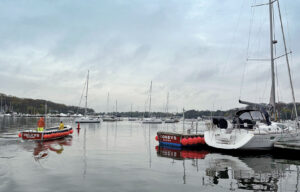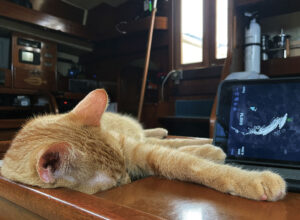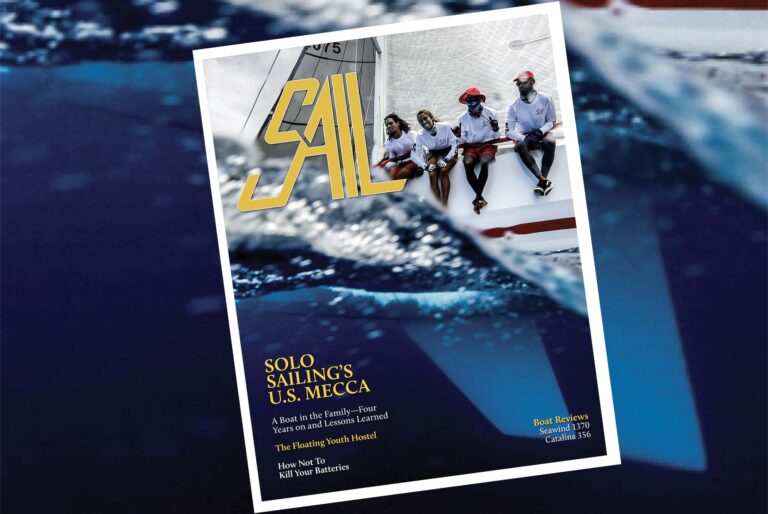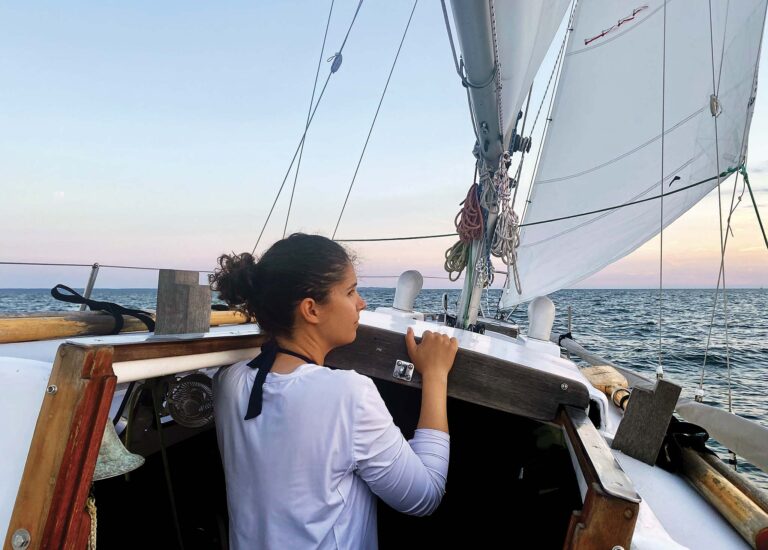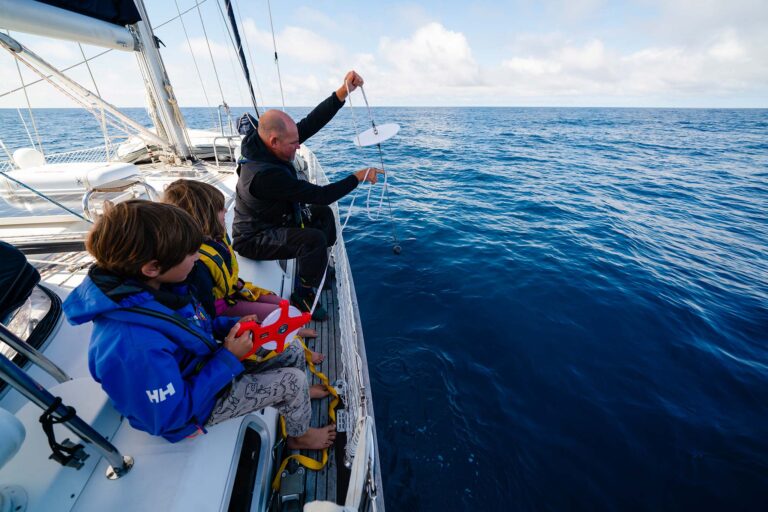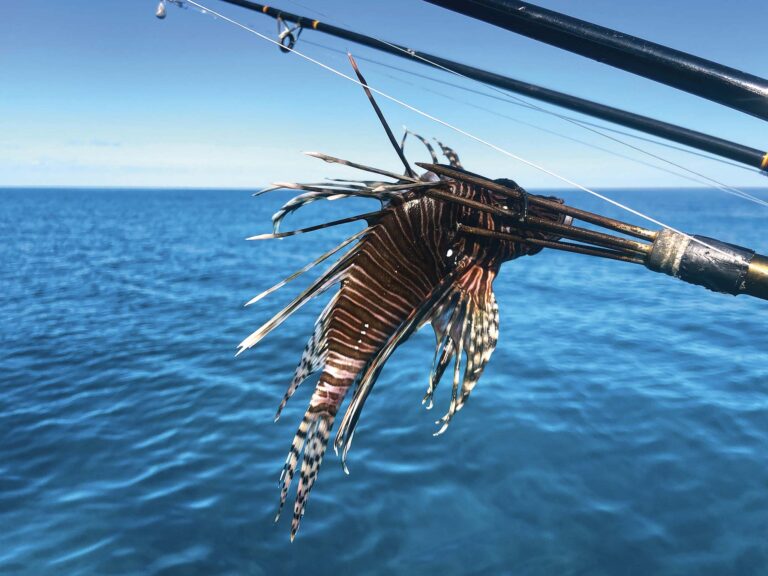This story was adapted from Andy Schell’s SAILfeed blog, written as it happened back in June. The post garnered lots of attention and lots of comments, and it’s worth taking another look at the incident to see what other people might have to say about it. Visit sailfeed.com to see the original post, with comments.
I was asleep on the port settee of the Hallberg-Rassy 43, Blue Heron. We’d been motorsailing all night, and the wind was veering as expected from SW to NE as we passed through a weak cold front. We were in the Gulf Stream, starting to make progress again in the right direction.
Loud voices and a luffing mainsail roused me. I grabbed my glasses and peered out the companionway to see what the commotion was all about. Behind us—just yards away—loomed the dull gray form of a large ship. We hadn’t collided—if we had, I might not be writing this—but only thanks to the quick reactions of Blue Heron’s owner, who’d thrown the helm over when he realized what was happening.
I’d been hired to skipper Blue Heron on a shakedown cruise from New York City to Bermuda and back. Blue Heron’s new owners were eager to get offshore and had organized a few of their friends to sail as crew. I’d also hired a Swedish friend named Oskar to come along as my mate.
We’d left New York City on schedule, despite a horrid forecast of 25 knots of wind, mostly on the nose, and had eventually given up on pounding to windward, easing sheets and turning south toward Charleston, South Carolina, instead. The point of the cruise wasn’t to get to Bermuda so much as to get in some ocean miles, and it looked like Charleston would be a much easier destination.
Soon afterward, though, the low pressure system that had stalled between the United States and Bermuda moved offshore, the wind shifted north, and the crew, now fully acclimated to life at sea, decided we should go for Bermuda after all. The rest of the outward leg was beautiful sailing—close- or beam-reaching on port tack right on through the next few days. We sailed into St. George’s just after dawn, and though we’d sailed an extra 200 miles to get there, it was a dream arrival.
Two days after that, it was time to head back to sea. Jennifer, who’d joined us for the outward leg, flew back home to Brooklyn, and we welcomed Alyce for the return leg, keeping the crew at five strong. Leg two started slow and hot. We motored in almost no wind for the first 24 hours, then set the spinnaker as the wind built, which it continued to do until it was blowing 25 knots. Soon Blue Heron was surfing down waves, still in control, but only just, and only by hand steering. Dousing the chute was tense, but the crew performed flawlessly.
We lost the wind again a few days later and reverted back to motoring. It was then that the unthinkable almost came to pass.
Afterward, I debriefed Doug and Alyce, who were on watch, to get an idea of what had happened. They’d had the graveyard shift, from 0000-0300, and around 0030 a Navy ship came on the radio asking them to change course so that they could sail safely by. Doug obliged and the two vessels went their separate ways. The ship was even on AIS, “USNS APACHE,” which is rare for military vessels. The weather was breezy with winds from the NNE, but otherwise clear.
Shortly thereafter, Doug and Alyce identified another set of lights on the horizon to starboard and started monitoring them. There was nothing on the AIS. Although Blue Heron was outfitted with radar, we didn’t have it turned on. Nobody aboard, myself included, felt comfortable using it, so we’d elected instead to maintain a vigilant visual lookout.
Although both Doug and Alyce were unsure of the new lights, they eventually concluded it must be a platform of some sort, something stationary, so Doug altered course slightly to port. The object, however, remained on a constant bearing (though Doug didn’t realize this at the time), so he altered course some more. Eventually, and almost too late, Doug realized his mistake—it was a ship and had actually been moving. Doug���s course alterations were simply keeping us on a collision course. In the end, he turned hard to port and actually did a loop to let the vessel pass—barely. It wasn’t funny-close. It was scary-close.
The next night we had another crossing situation. I was on watch and decided to wake Doug up for another “simulation,” this time under controlled circumstances. I covered up the AIS and asked him to come on deck to have a look around and tell me what he saw. At the time we had a ship off to port, its lights barely visible on the horizon about 35 degrees off the bow. We could see two white lights—a low bow light and a higher light aft, indicating the ship was more than 150ft long. We could also see a green sidelight under the aft steaming light, indicating the ship was moving SE, across our bow.
I taught Doug how to take a simple bearing on the lights using a shroud on the boat as a reference point to see if we were in another CBDR (constant bearing, decreasing range) situation. It was hard to tell at first—the ship was still pretty far off—but as we closed, it was pretty obvious he was moving safely across our bow and that if we held course and speed, the ship would pass in front of us.
Commercial ships usually have yachts targeted on their radar and often will cross much closer to you than you might think comfortable. If they don’t have to alter course, they won’t—the captain probably isn’t awake, and they’re on a schedule, so crossing a half-mile in front of your bow is well within their safety margins.
Of course, those same margins might not be enough for you, so you it pays to plan ahead. Figure out what margins you think are best—maybe a quarter-mile on inland waterways, but a mile offshore—and then act accordingly. Even if you’re the stand-on vessel, you can always safely alter course to pass astern. When doing so, always make a dramatic course change—turn 90 degrees and show the other vessel a different side light so your intentions are clear.
Ultimately, Doug’s mistake that fateful night was altering course in the wrong direction. Had he simply steered toward the stern of that ship rather than the bow, we’d never have come anywhere near it. That said, I’m still confused as to what that ship was doing. No AIS and never a horn signal, a spotlight or anything. They had to know we were there, especially if it was a Navy vessel. I suspect there was something weird going on that night. Still, the most important thing is that we’re safe and much smarter for the experience.
What We Did Wrong
Doug’s first mistake was not waking the skipper. Everything else followed from that. I was partially to blame and was not clear enough in my standing orders on when I should be woken.
As skipper, I should have briefed the crew better on the chart for that part of the ocean.
Nobody onboard felt comfortable using the ship’s radar. Had we been more knowledgeable, we could have used the radar to determine that the ship in question was in fact moving toward us. We had not properly discussed how to determine a CBDR situation at night, nor had we discussed rules of the road.
What We Did Right
The boat was well equipped for ocean sailing and beautifully refit.
We had the proper lights on for motorsailing offshore—deck lights and a steaming light.
Blue Heron’s owners hired a professional (me) to take them offshore for the first time, and other than this incident we had a fabulous trip. They learned a lot and gained confidence.
Postscript: the U.S. Navy Responds
Late one evening while Isbjorn, our Swan 48, was at sea in the Caribbean 1500, I received an email from a Jose Delfaus. Mr. Delfaus was emailing me about my article ‘Midnight Encounter with a Navy Ship’ (SAIL Dec. 2015). Jose was there that night and witnessed the whole thing. He was Master of the USNS Apache, a US Navy ocean towing vessel, and indeed the ship Blue Heron’s owner spotted on AIS that night.
“The USNS Apache was towing a decommissioned submarine, the Ex-Miami” wrote Delfaus. “We were displaying navigation lights indicating it was towing and the AIS was configured to relay the same,” he continued.
Recall from my article that as skipper of the HR43 Blue Heron, I was off watch and asleep on the portside settee while all of this was happening. The email from Jose was eye-opening.
“The guided missile destroyer USS James E Williams DDG 95 was acting as escort,” continued Delfaus.
As I hypothesized, Delfaus went on to explain that the Williams was not in fact transmitting on AIS as “typically US Navy combatants wouldn’t,” and was challenging all surface traffic with close approach to the Apache tow on VHF.
“I suspect that the visual sighting was in fact that of our escort vessel, USS James E Williams,” Delfaus added. “And by the way, the Apache doesn’t have a flight deck” – the ship we encountered did – “but the Williams does, and in fact had a helicopter there that night.”
Delfaus’ email was welcome and enlightening. While I haven’t spoken to the master of the Williams (I’m trying to reach out to that person), Delfaus’ email makes it clear to me now that the ship in question knew we were there all along, and was merely doing a ‘fly-by’ to check us out. The misinterpretation of the on-watch crew at what was actually going on only exacerbated the encounter. I believe now that while close, we were never in any real danger of collision.
Andy Schell is a professional sailor, writer and host of the “59º North” sailing podcast. He runs offshore passage expeditions on his classic Swan 48 Isbjörn through59-north.com. He and his wife, Mia Karlsson, also manage the Caribbean 1500 rally.

